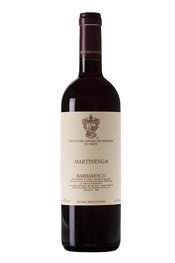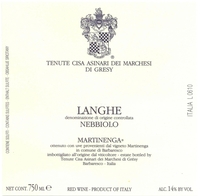 ardent fans but for a wine with less than half as much production on average and a less powerful style, that fan base is much smaller than Barolo’s.
ardent fans but for a wine with less than half as much production on average and a less powerful style, that fan base is much smaller than Barolo’s.
While some wineries in Piedmont produce both Barolo and Barbaresco, most of the top-notch wineries specialize in one or the other, depending on where their estate is situated. The soils of the two areas are similar, but the hills of the Barbaresco zone are slightly lower in elevation than those in Barolo and the grapes ripen slightly earlier. Furthermore, DOCG regulations require only two years of aging before release for Barbaresco compared to three years for Barolo. Therefore, Barbaresco is generally ready to drink sooner than the famously long-lived Barolo. And while Barbaresco is not shy in tannin, the tannins tend to be less fierce than Barolo’s. “Elegance” and “finesse” are common descriptors of Barbaresco.
Within Barbaresco, different producers and their various vineyards have different styles on the spectrum ranging from intense to elegant. Marchesi di Gresy’s Barbaresco wine epitomize elegance and delicacy. The flagship vineyard of the estate, Martinenga, is considered among the finest in the Barbaresco zone and is the only single-family monopole vineyard in the region. Marchesi di Gresy produces three Barbaresco wines from this vineyard: Martinenga, Gaiun and Camp Gros Riserva, from several different clones of Nebbiolo.
Marchesi di Gresy’s current releases include the 2017 Barbaresco Martinenga ($65) and 2019 Nebbiolo Langhe Martinenga ($26), as well a 2018 Barbera d’Asti ($19) which comes from a separate family-owned vineyard called La Serra, situated in the province of Asti (as opposed to Cuneo province, where Barolo and Barbaresco are located).
Naturally, Martinenga Barbaresco 2017 is the star of this show. It’s dry and full-bodied with high acid and lots of lean, edgy tannin — classic Nebbiolo structure. The uplifted aroma shows ripe red cherry, tart cherry, anise, lavender, strawberry, tar and a savory mineral note. In your mouth, these flavors are fresh, vibrant, and pure, while the wine’s texture is silky (once your palate adjusts to the tannins), ending in a long, flavorful finish of delicate but concentrated fruit. Although this wine has concentration of fruit and good weight, it is very delicate and elegant. Enjoyable now but its intensity and concentration of fruit and its long finish indicate it has a few years to go before peaking and can age for ten-plus years.
Nebbiolo Langhe Martinenga 2019 comes from a different part of the Martinenga vineyard, where eleven clones of Nebbiolo are cultivated and studied for research. The grapes for this wine were selected as better suited to make a lighter style of Nebbiolo than Barbaresco itself. In fact, the wine is rather light-bodied with a structure that’s driven mainly by high acidity, its moderate amount of grainy tannin emerging only on the rear palate. Aromas and flavors include tart cherry, strawberry, a chalky minerality and sweet spice. This is an edgy, energetic and flavorful wine with up-front fruitiness,  very easy to enjoy now but suitable for keeping for a few years. In a wide glass, the wine is softer and less edgy.
very easy to enjoy now but suitable for keeping for a few years. In a wide glass, the wine is softer and less edgy.
It strikes me how different this Langhe Nebbiolo is from many other brands that are available, particularly those from producers in the Barolo zone. The production area for Nebbiolo Langhe is large, encompassing all of Barolo and all of Barbaresco as well as the Roero DOC zone on the far side of the Tanaro River, where the soil is sandier and the wines can be lighter. With so many fruit-sourcing options, producers can make a whole range of styles. Some wines are ripe, fruity and substantial in body, like readier-to-drink, declassified Barolos. Others have partial barrique aging. As much as many of us enjoy Nebbiolo Langhe, and as attractive it is in terms of price, you cannot be sure of the style you will find in any one wine. I have been purchasing Marchese di Gresy Martinenga Nebbiolo Langhe for many years and have seen the winery’s commitment to the style shown by the 2019 to be consistent, and reliable.
Apart from these Nebbiolo-based wines, Marchesi di Gresy makes several other wines from various properties that it owns, including the newly released 2018 Barbera d’Asti. This wine is, of course, deeper in color than the Nebbiolos, with the higher acidity typical of the Barbera grape and softer, riper tannins. This is a dry, medium-bodied wine with aromas and flavors of red and black cherry, pungent spice and a floral suggestion. It’s round and full in your mouth, rather fleshy compared to the Nebbiolos, and yet it is not heavy because its high acidity supports the wine’s richness and keeps the wine light on its feet. This dynamic is one of the wine’s most appealing aspects to me, making this Barbera far more interesting than just any smooth, fruity and flavorful red.
Barbaresco, 94 Points
Nebbiolo Langhe, 91 Points
Barbera d’Asti, 91 Points
